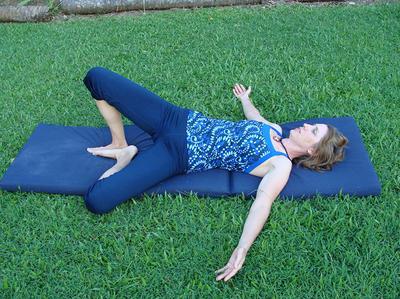Pelvic Floor Exercises for Uterine Prolapse
by SJS
(IL)
Wow! 2009 was not so kind to me.
Jan of 09 took a hard fall, which resulted in a uterine prolapse.
Finally in April, after trying numerous things to find pain relief, I opted for a total hysterectomy. The surgery was a success as far as the prolapse went, but 4 weeks post op I started with exteme vagianl pain.
Well - it is now Jan 2010 and thanks to a great physical therapist the pain is virtually gone and I have graduated. However, I still suffer from a very weak pelvic floor and (at 51) am begging to become hunchbacked - I would like to correct both of these issues and have been looking into Pilates - however, have read some articles stating that this may not be the best designed program for women.
Can you shed some light on the issue - I would hate to do any more pelvic floor damage and not sure what exercises (or positions) to stay away from.
Jennifer's Response:
Pilates is a very well designed program for women not only for the core strength you gain, but especially the pelvic floor specific exercises.
The main concern for you with the uterine prolapse in doing any type of exercise, especially pelvic floor exercises would be to make sure you are breathing properly.
It is imperative that you exhale when exerting on any type of exercise to avoid the valsalva manuever, which could result in a recurrence of the prolapse.
This breath is actually true for anyone who is exerting themselves with any type of exercise, especially weight bearing of a heavy load.
For instance, if you are doing a frog leg exercise, which targets the pelvic floor muscles you should exhale as you extend the heels away from your sitz bones drawing the inner thighs together at the end and keeping the feet slightly turned out. Then inhale to pull them back with your knees apart.
To really feel the pelvic floor muscles working imagine either drawing the sitz bones up and towards the navel or bringing the coccyx and pubic bones closer together as you exhale.
Use this technique with the image above. Inhale to allow one leg to move to the side and exhale squeezing from the pelvic floor muscles to draw it back up to the center. Repeat on the other side.
I always cue my students as well as on my Pilates DVD's and the Pilates Ebook available here, when and how to breathe correctly throughout their exercise session.
Check out this page to find out more about proper breathing techniques.
Pilates can also be very good for Kyphosis or the "hunchback" that you are experiencing.
Your focus should be on improving your posture with extension type exercises, stretching the upper chest and hamstrings, and avoiding excessive flexing of the spine.
Check out this page to find out more about how to correct your Kyphosis.
 | Get Instant Access to Loads of Color Pictures, Postures, and Information Designed to Increase Comfort and Happiness. Learn to Enjoy Life Again! Learn More! |


